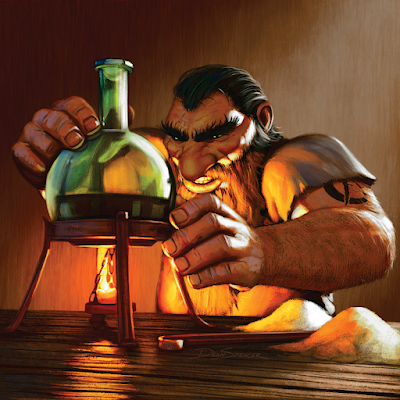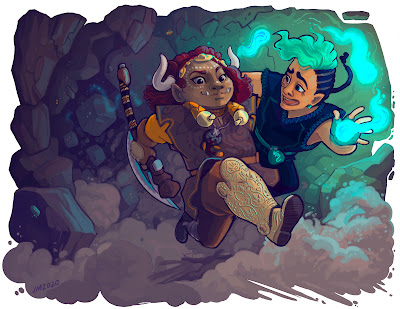So the last time I posted about #CORE20RPG was the end of December. I had great plans then for doing regular updates, and a bunch of stuff already queued up to show and talk about as regards the game and some of its inner workings.
And then Wizards of the Coast had a little thing happen with the Open Game License.
Maybe you didn’t hear about that? You can go look into if you like. I’ll wait.
You’re back? Excellent.
When I wrote up the first draft of the first bits of CORE20 as an actual game system, building on the collection of house rules the game was for the first couple of years, it was fiercely and proudly a product of the OGL.
Those first rules were built not just around the D&D 3.5 SRD, but on other OGL material including the 3.5 “Unearthed Arcana” — a book of optional rules that WotC released as Open Game Content so that everyone could use those rules to create new works. As the OGL intended.
For a long while, I’ve been wanting to find the time to turn CORE20 into something other people could test and play. And during all that time, I emphatically embraced the reality that the game was a product of the OGL.
The foundations for creativity that WotC laid for open gaming were a big part of what brought me back to D&D in 3rd edition, and eventually to work on the game — for WotC, and others — for eighteen years. For a long while, the idea of creating an OGL game was a point of pride.
And all those feelings are supremely bittersweet now, because certain people at Wizards of the Coast have looked at the multiple worlds’ worth of wondrous imagination that have come out of the OGL over two decades and decided:
“Yeah, fuck that.”
So the last few weeks haven’t been great for me, as for so many other people in a creative community that I’m proud to be a part of. Because I’ve had to think a lot more than I ever expected to about how I want this game to come out.
In December, rumors started swirling in earnest to suggest what some of us had guessed at months before — WotC wasn’t planning to release 6th edition under the OGL. And at that time, I assumed the same thing that most creatives working in the OGL community assumed.
We assumed that Wizards of the Coast would be pulling a 4e by bringing 6e out under a new license. A closed license. We wondered if they’d sweeten that closed license for some folks with the chance to put third-party products onto D&D Beyond at long last. We speculated a lot.
We heard about companies being asked to sign NDAs, which seemed to confirm those speculations. 6e would break from the OGL. But hey, we’d still have the OGL, right? The wealth of material produced for D&D, the huge base of 5e players — none of that was going away.
Right?
Anyway. Unless WotC does an even sharper about-face with the next draft of their new OGL, there’s not a chance I’ll be signing on. (Other people have noted the problems of OGL 1.1 far more comprehensively than I can. I’m not going to recap the issues.)
Wizards is now promising that any game released under OGL 1.0a can stay that way. And CORE20 is already and has always been an OGL 1.0a game. People have seen it, people have read it, people have playtested earlier versions on the way to making it the game I wanted it to be.
And even if WotC reneges on that promise, as they’ve reneged on the promises made when the OGL was created, here’s a thing. Most of what came into CORE20 via the SRD has already been rewritten. Much of what’s in the wildly-being-finalized open-playtest draft is brand new.
The foundations and palimpsests marking where the game came from are clearly visible, as intended. But there are precious few direct lifts from any SRD in the game, and it won’t take much work to polish those direct lifts into their own thing if that becomes necessary.
So, whatever happens, #CORE20RPG is absolutely coming out. It’s coming out as the game I want it to be, and as part of the larger movement of creativity that is the legacy of the OGL. Even if there’s no OGL left.
Lots of other amazing, creative folks have announced that they’re responding to WotC’s OGL debacle by creating their own games. Building on what D&D means to them, by homage and inspiration.
And apparently, without meaning to be, I’m one of them.
I’ll be getting back on schedule with previews and updates next week, which you can find here at the design blog.
I’ve been playing CORE20 for years, and having an incredible amount of fun, even as I’ve been looking at it constantly and thinking to myself:
“This can be more. This can be amazing.”
Now I get to find out if I’m right.
• • •
Addendum
Literally four hours after I wrote and posted the above, Wizards of the Coast made the unexpected announcement that they were abandoning plans to implement an updated OGL, and that they had taken the extraordinary move of releasing the D&D 5th edition SRD under Creative Commons, in addition to its existing availability under OGL 1.0a.
(The story’s here if you somehow haven’t heard it. I’ll probably talk about this at some point, but am too generally giddy to do so today.)
The path forward for CORE20 still isn’t as 100 percent certain as it was prior to this past month, because although a promise has been made to leave OGL 1.0a untouched, that promise carries a tiny bit less weight than it did before the time that WotC decided it could revoke 1.0a. On the other hand, there’s been talk that Wizards might well release earlier editions’ Open Game Content into Creative Commons — including the 3.5 SRD that was the first SRD used to shape the game that CORE20 has become.
But this is huge news either way, and Wizards of the Coast deserves huge thanks for listening to what the creative community told them, and for understanding finally the real harm they were doing to themselves, their brand, and the community that loves the game.
(Art by Dean Spencer)





.png)
.png)
%20Big.jpg)


.jpg)


.jpg)
.png)



